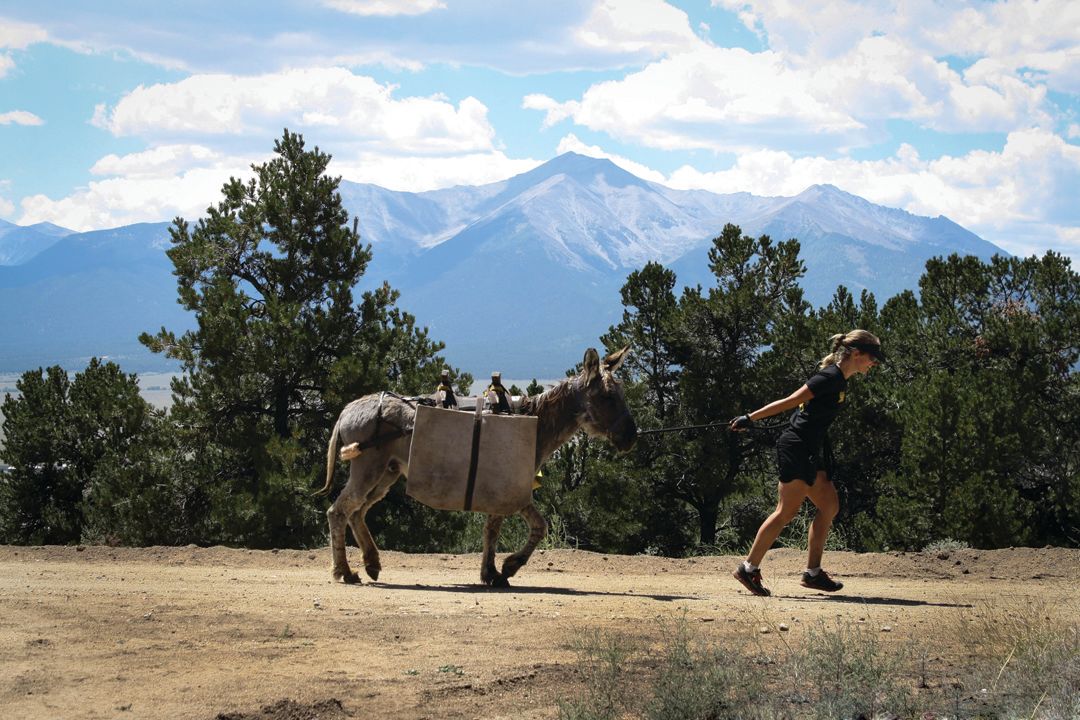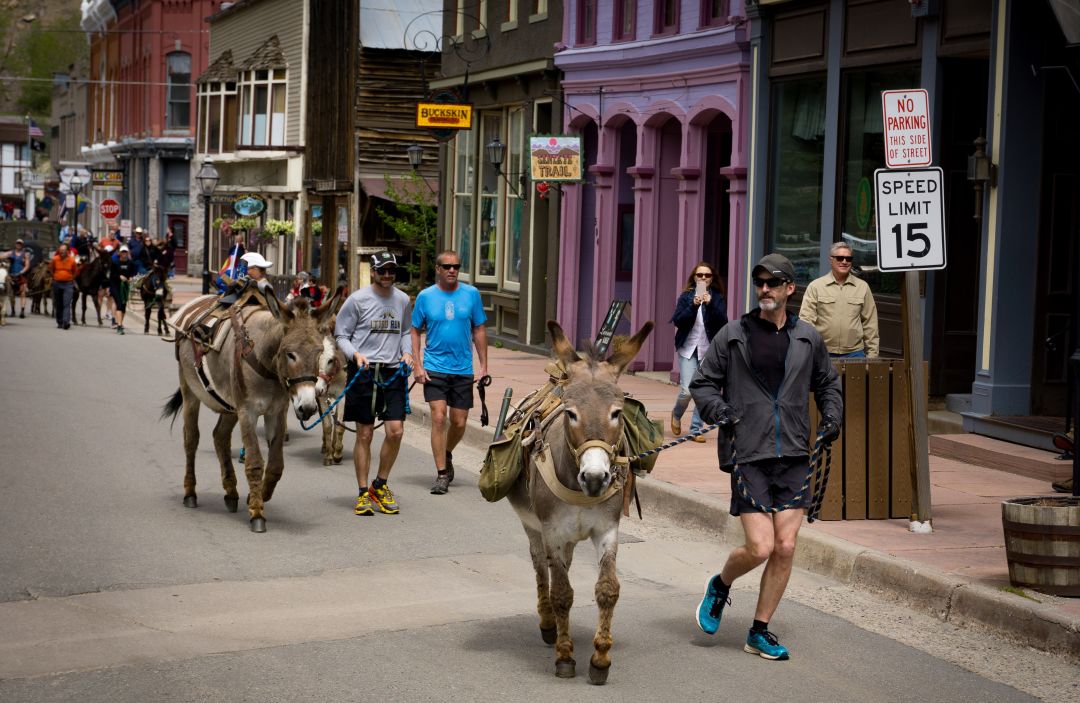Get Your Ass in Gear and Go Burro Racing This Summer

Lindsay Jones, of Carbondale, and Bandit race in Buena Vista.
Image: Jennifer Mewes
Running with your dog is a universal pastime. But running with a burro (the Spanish word for donkey), well, that’s a distinctly Colorado experience. Named a Colorado Summer Heritage Sport by the state legislature, pack burro racing takes place during a lively season-long series that includes a “world championship” and prize money. The goal is to see which human and burro team is the fastest to, as racers like to say, “get yer ass over the pass.”
This curious sport’s origins are steeped in legend, with two common hypotheses. One is that two gold prospectors were racing back to town to be the first to stake a claim. Since their burros were weighed down, the men ran instead of rode. (Today, “no riding your burro” is a strict rule of racing.) The second proposition involves a boozy challenge and cash prize for the fastest burro-human pairing to make it from Leadville to Fairplay over Mosquito Pass.
What began as a hobby for miners now draws participants ranging from enthusiastic hikers to professional runners. In a nod to Colorado’s mining heritage, required equipment includes a burro (available to rent), regulation packsaddle, pick, shovel, and gold pan (all included with burro rental). The saddle and gear must weigh a minimum of 33 pounds. Because donkeys are as stubborn as their reputation suggests, a lead line is also required.
Overseen by the Western Pack Burro Ass-ociation, competitions make donkey safety the priority. Veterinarians are on hand at races, burros are well cared for, and any animal cruelty warrants a lifetime ban. Human competitors aren’t as coddled. As the race website (packburroracing.com) states: No ribbons. No wimps. No age groups.
A dedicated runner, I gave burro racing a try last summer on a 9-mile out-and-back course in Georgetown. It involved plenty of braying, some serious sweat effort, and recalling a lifetime’s worth of relationship advice to keep a temperamental burro heading in the right direction. My four-legged partner was Winky, a mini burro with soulful eyes who preferred singletrack to roads, liked running hip-to-hip, and despised apples—something I found out the hard way.
I convinced my 17-year-old daughter to run with us. Teams of three aren’t the norm, but I was nervous and she was willing. After charging out of town at a redline pace—burros can run 20 to 30 miles per hour for short distances and have no trouble holding sub-six-minute miles for races—the three of us settled into a comfortable trot. But burro racing is no genteel affair. I saw a successful ultrarunner flummoxed by a stubborn ass with one speed—slow. Other competitors lost their footing as they were dragged by overeager donkeys. And we were all left guessing as to the next thing to pique our companions’ interest. Carrots or apples are often used as rewards, but Winky was having none of it. Instead of enjoying his trail snack, the obstinate fellow would stop dead in his tracks, refusing to move until all vestiges of the offensive fruit were out of sight.
Toward the end of the race, unlike a horse headed to the barn, Winky wasn’t into the finish line sprint. Maybe he wanted to savor the cheering crowds, or maybe he didn’t like the announcer’s hat. Whatever the reason, we managed to finish. No gold claim or cash prize awaited us, but we did have plenty of apples.
I have no idea how long it took our merry band to complete the course because I didn’t have a watch—wearing one is discouraged as lead lines may get stuck on it. And unlike at most races, no clock loomed large at the finish line. Many burro racers claim that every finisher is a winner, and I couldn’t agree more.
I’ll be giving it another try this summer at a half-marathon in Buena Vista. This time I’ll meet up with my four-legged race partner, Vernon, for a couple of training days before the main event. My daughter is undecided on whether or not she’ll toe the line with us—running with a burro and her mom was a bit stressful. One thing I do know for sure: I’ll bring apples and carrots. packburroracing.com

Image: Jay Holland
Upcoming Events
- May 27: Georgetown, Historic Georgetown Railroad and Mining Days Pack Burro Race, 8–9 miles
- June 10: Creede, Inaugural Creede Donkey Dash, 7–8 miles,
- July 23: Idaho Springs, Tommyknockers Mining Days Festival and Pack Burro Race, 4–6 miles
- July 30: Fairplay, 69th Annual World Championship Pack Burro Race, 15 and 29 miles
- August 6: Leadville, 69th Annual Boom Days Pack Burro Race, 15–21 miles
- August 13: Buena Vista, Gold Rush Days Pack Burro Race, 13 miles
- September 9: Victor, Burro Racing Gold Rush Challenge, 12 miles
Burro Racing Philosophy
Amber Wann of Highlands Ranch and her father began burro racing in 2008. Her husband started racing the next year, and now their children compete, too. Here, her philosophy on tackling the course with a four-legged, sometimes stubborn, partner:
- Whether you train all year with your own burro or rent one for a bucket list experience, remember that in these races, the burros rule. Even more satisfying than winning, perhaps, is when a racer/burro connection is made on course and a mutual understanding achieved.
- A person can come back year after year with the same donkey on the same course and always have a different experience. Let go of your expectations and know there will always be a grand story to tell.
- Pack burro racing is like life, with ups and downs along the way and obstacles to avoid or get around. During a race you’ll likely vary between sprinting, cruising along, dragging ass, or being at a dead stop. No matter how slow you go, just try to keep moving and never give up on your donkey.













































